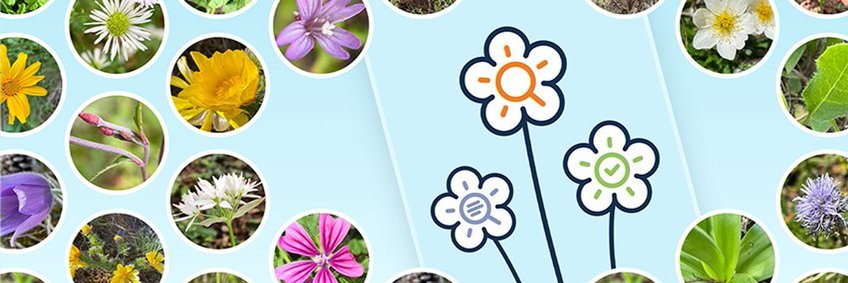
Biod.AI.versity Observation & Integration (Bio.AI)
Dr. Jana Wäldchen
Our mission
The research group focuses on three main areas:
a) Automated and integrative species identification
b) Biodiversity monitoring and ecosystem functioning
c) Citizen Science
Automated species identification
One focus of the "Biod.AI.versity Observation & Integration" research group is the advancement of automated species identification (Wäldchen and Mäder, 2018).
This ongoing research endeavor has led to the development of pioneering methodologies that bridge the fields of computer science and botany. The research group has placed particular emphasis on systematically evaluating different image perspectives specific to plant species (Rzanny et al. 2022, 2019, 2017). This approach enables a more comprehensive understanding of plant morphology and characteristics, significantly enhancing the accuracy of automated species identification systems. A notable outcome of this research is the creation of the Flora Incognita App, designed for interactive automated identification of vascular plant species, encompassing over 16,000 species (Mäder et al. 2021).
Moreover, the group is actively working on methodologies to combine DNA and image data for integrative species classification (Kösters et. al. in prep, Karbstein et al. 2023). In collaboration with iDiv and UFZ Leipzig, the group is also developing a monitoring approach for species-specific analysis of phytoplankton samples (Dunker et al. 2018).
Key Publications:
- Karbstein et al. (2023) Species Delimitation 4.0: Integrative Taxon-omics and Artificial Intelligence. Trends in Ecology and Evolution (in press)
- Rzanny et al. (2022) Image-based automated recognition of 31 Poaceae species: The most relevant perspectives Frontiers in Plant Science,12: 804140.
- Mäder et al. (2021) The flora incognita app–interactive plant species identification. Methods in Ecology and Evolution. 12: 1335– 1342.
- Rzanny et al. (2019) Flowers, leaves or both? How to obtain suitable images for automated plant identification Plant Methods 15, 77.
- Wäldchen and Mäder (2018) Machine learning for image based species identification. Methods in Ecology and Evolution 2018;00:1–10.
- Dunker et al. (2018) Combining high‑throughput imaging flow cytometry and deep learning for efficient species and life‑cycle stage identification of phytoplankton BMC Ecology 18, 51.
- Rzanny et al. (2017) Acquiring and preprocessing leaf images for automated plant identification: understanding the tradeoff between effort and information gain. Plant Methods, 13(1), 97.
Biodiversity and ecosystem functioning research
Building on the extensive dataset from the Flora Incognita app generated by citizen scientists, the group's research has expanded, focusing on analyzing opportunistic plant occurrence data. In a first analysis we were able to uncover macroecological patterns with Flora Incognita observation data from a single vegetation season (Mahecha et al., 2020).
Furthermore, we have investigated the extent to which opportunistic data can complement systematic phenological monitoring (Katal and Rzanny et al., 2023). Our Europe-wide study has revealed that opportunistic citizen science plant observations unveil spatial and temporal gradients in phenology (Rzanny et al., 2024). These investigations underscore the invaluable insights that opportunistic data can furnish, thereby enriching our comprehension of ecological and phenological patterns on a broader scale.
In the newly established PollenNet project, we will predict the pollen distribution of allergenic plants. These areas of study are crucial for advancing our knowledge of ecological dynamics, biodiversity conservation, and the broader impacts of plant species on ecosystems and human health.
Key publications
- Rzanny et al. (2024) Opportunistic plant observations reveal spatial and temporal gradients in phenology. npj biodivers 3, 5
- Katal & Rzanny et al. (2023) Bridging the gap: how to adopt opportunistic plant observations for phenology monitoring. Front. Plant Sci. 14:1150956.
- Mahecha et al. (2021) Crowd-sourced plant occurrence data provide a reliable description of macroecological gradients Ecography (Editors‘ Choice).
Citizen Science, Education and Science Communication
Successful scientific work goes beyond the scientific community and extends to knowledge and technology transfer to society. The Flora Incognita project, in particular, has garnered public attention and engagement. Using the Flora Incognita App, we explore methods of effective knowledge transfer in various forms (badges, stories, and more) (Bebber und Wäldchen, 2024, Wäldchen et al., 2022). From the very beginning of the project, the dissemination of the results was carefully planned. As a result of these efforts, the work has gained widespread recognition and international visibility through television, press coverage, and active participation on social media platforms. This publicity has not only facilitated broad dissemination but has also generated significant interest in scientific endeavors. In the new project „Forest Doctor“, we will expand our communication strategies toward forest dieback and tree diseases and discuss the possibilities of a Citizen Science project for recording damage to woods.
Key publications
- Bebber and Wäldchen (2024) Flora Incognita – mehr als Pfanzenbestimmung. Biologie in Unserer Zeit, 54(1), 29–31.
- Wäldchen et al. (2022) Towards more effective identification keys: A study of people identifying plant species characters. People and Nature.
Key Public Events
Since the start of the project, we have been engaging in 1:1 dialogue with users and interested parties at public events, such as:

- interactive exhibit on board of the museum vessel MS Science
- urban botany excursion “More than Weeds” (Krautschau)
- interactive exhibition at re:publica conference
- workshops for teachers
- Long Nights of Science
Team





